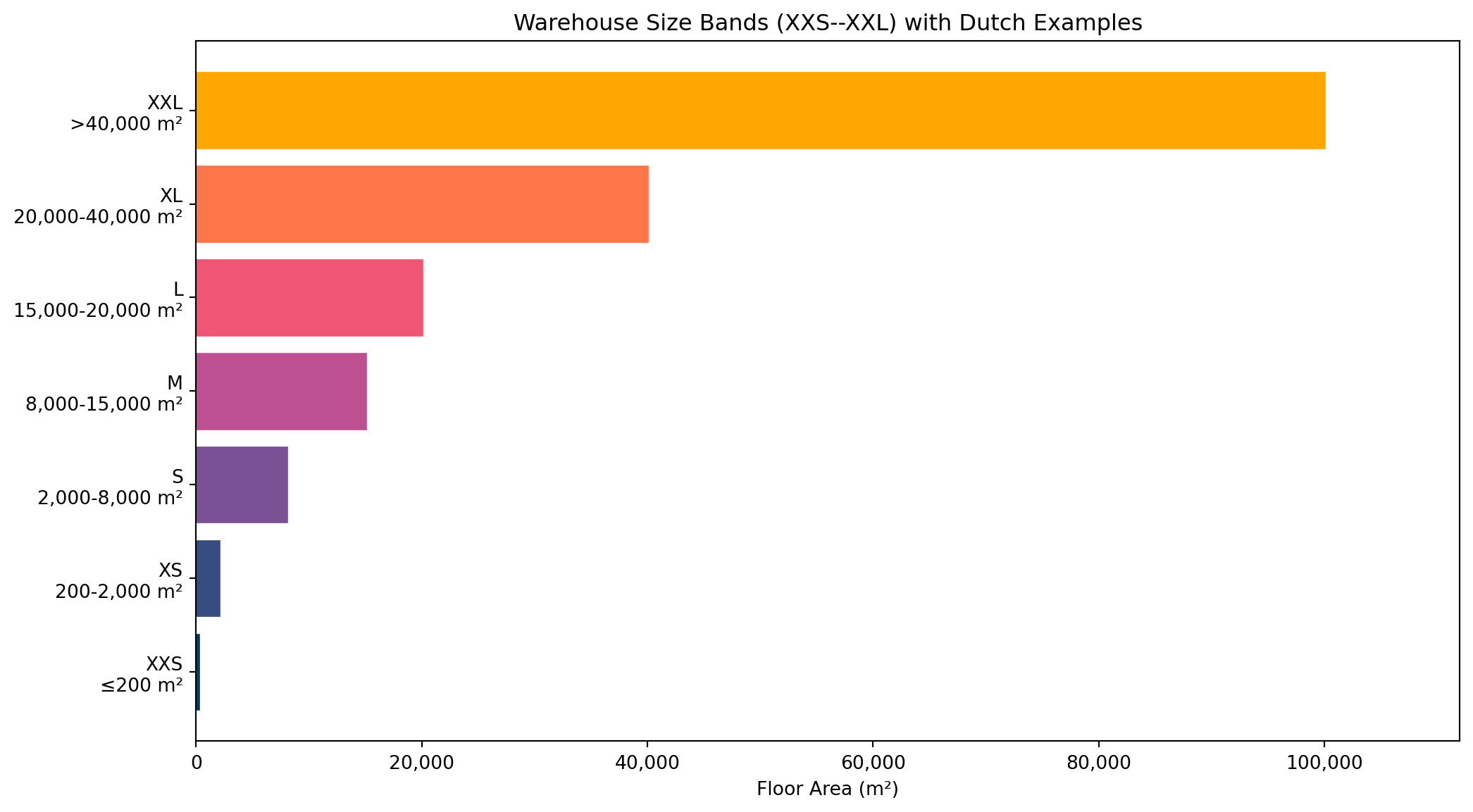flowchart LR
subgraph T0["Raw Material<br>Supplier"]
direction TB
S1["S1"]
S2["S2"]
S3["S3"]
end
subgraph T1["Manufacturing<br>Plant"]
direction TB
P1["P1"]
P2["P2"]
P3["P3"]
end
subgraph T2["Manufacturing<br>Warehouse"]
direction TB
MW1["MW 1"]
MW2["MW 2"]
MW3["MW 3"]
MW4["MW 4"]
end
subgraph T3["Wholesaler<br>Warehouse<br>"]
direction TB
WW1["WW 1"]
WW2["WW 2"]
WW3["WW 3"]
end
subgraph T4["Retailer<br>Warehouse"]
direction TB
RW1["RW 1"]
RW2["RW 2"]
RW3["RW 3"]
RW4["RW 4"]
end
subgraph T5["Retail Store"]
direction TB
RS1(("A"))
RS2(("B"))
RS3(("C"))
RS4(("D"))
end
S1 --> P1 & P2 & P3
S2 --> P1 & P2 & P3
S3 --> P1 & P3
P1 --> MW1 & MW2
P2 --> MW2 & MW3
P3 --> MW3 & MW4
MW1 --> WW1
MW2 --> WW1 & WW2
MW3 --> WW2 & WW3
MW4 --> WW3
WW1 --> RW1 & RW2 & RW4
WW2 --> RW2 & RW3 & RW4
WW3 --> RW1 & RW3 & RW4
RW1 --> RS1 & RS2
RW2 --> RS2 & RS3
RW3 --> RS1 & RS4
RW4 --> RS3 & RS4
```@{ label: "```" }
S1@{ shape: rect}
S1:::supplier
S2:::supplier
S3:::supplier
P1:::plant
P2:::plant
P3:::plant
MW1:::mwh
MW2:::mwh
MW3:::mwh
MW4:::mwh
WW1:::wwh
WW2:::wwh
WW3:::wwh
RW1:::rwh
RW2:::rwh
RW3:::rwh
RW4:::rwh
RS1:::store
RS2:::store
RS3:::store
RS4:::store
classDef supplier fill:#eff6ff,stroke:#1d4ed8,stroke-width:1px
classDef plant fill:#e0f2fe,stroke:#0ea5e9,stroke-width:1px
classDef mwh fill:#dcfce7,stroke:#10b981,stroke-width:1px
classDef wwh fill:#fef3c7,stroke:#f59e0b,stroke-width:1px
classDef rwh fill:#fde68a,stroke:#d97706,stroke-width:1px
classDef store fill:#fee2e2,stroke:#ef4444,stroke-width:1px
linkStyle 29 stroke:#757575,fill:none
linkStyle 30 stroke:#757575,fill:none
linkStyle 31 stroke:#D50000,fill:none
linkStyle 32 stroke:#D50000,fill:none
linkStyle 33 stroke:#2962FF,fill:none
linkStyle 34 stroke:#2962FF,fill:none
linkStyle 35 stroke:#00C853,fill:none
linkStyle 36 stroke:#00C853,fill:none
4 Warehouse Functionality
The wise adapt themselves to circumstances, as water molds itself to the pitcher. —Chinese Proverb
4.1 🧠 Learning Objectives
- Understand warehouse functions in supply chains.
- Recognize main warehouse types.
4.2 Supply Chain Network
4.3 Warehouse Mission
The traditional mission of a warehouse is to effectively ship products in any configuration to the next step in the supply chain without damaging or altering the product’s basic form.
4.4 Warehouse Functionality
Distribution facilities perform several key functions to support supply chain operations (Coyle et al. 2020):
- Accumulation
- Sortation
- Allocation
- Assortment
- Value-Adding
Distribution Facility Functionality Distribution facilities can provide numerous services, depending on the requirements of the supply chain. In traditional distribution operations, four primary functions are carried out: (1) accumulation, (2) sortation, (3) allocation, and (4) assortment.2
Page 398 2023-03-11#5:14 pm
4.4.1 Accumulation
DC serves as a collection point:
- Transfer, storage, and processing services.
- Consolidate orders and shipments.
- Cost-efficient deliveries.
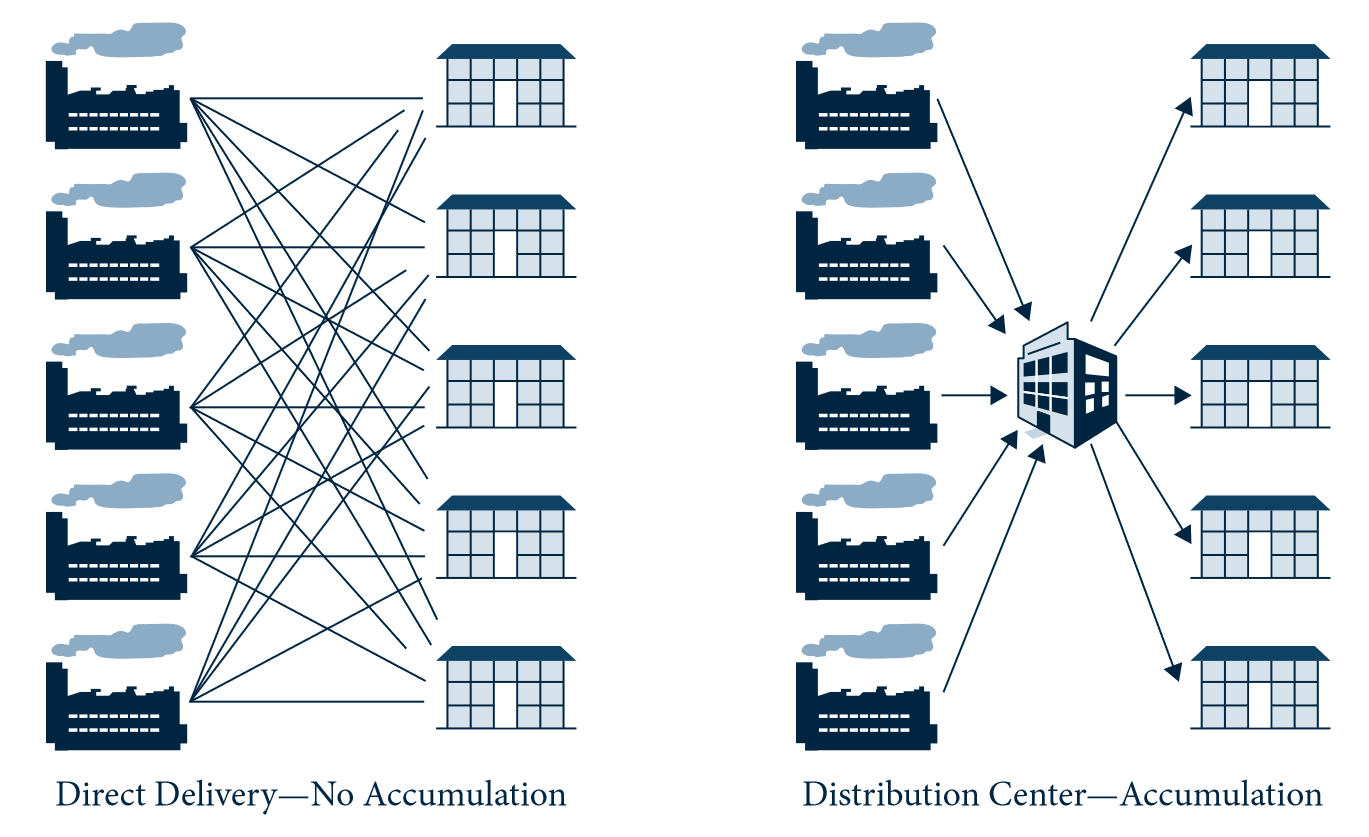
Accumulation :: involves the receipt of goods from a variety of sources. The DC serves as a collection point for product coming from multiple origins and provides required transfer, storage, or processing services. The accumulation function allows organizations to consolidate orders and shipments for production and fulfillment processes. As Figure 10.1 demonstrates, with accumulation there are fewer deliveries to schedule and manage. Also, significant transportation cost savings are achieved through larger, more cost-efficient deliveries to a central distribution point.
Page 398 2023-04-26#11:47 am
Page 398 2023-03-13#9:01 am
4.4.2 Sortation
Assembly of like products together for:
- storage in the distribution facility,
- processing, or
- transfer to customers.
Upon receiving, goods are:
Segmented according to their key characteristics, for example:
- production lot number
- stock-keeping unit (SKU) number
- case pack size
- expiration date
Prepared for safe storage in the facility or immediate distribution.
Sortation focuses on assembling like products together for storage in the distribution facility, processing, or transfer to customers. During the receiving process, goods are segmented according to their key characteristics—production lot number, stock-keeping unit (SKU) number, case pack size, expiration date, etc.—and prepared for safe storage in the facility or immediate distribution.
Proper sortation is essential for the effective management of inventory and fulfillment of customer orders.
For example, mixing cases of fresh chicken with two different expiration dates on a single pallet can lead to improper inventory rotation and some product spoilage. Likewise, improper sortation of SKUs may result in shipping the wrong products to customers.
Page 399 2023-04-26#12:18 pm
4.4.3 Allocation
Focuses on matching available inventory to customers orders for a SKU.
Order is compared to inventory levels, and available units are retrieved from storage based on customer order quantities.
Break-bulk capacity promotes product availability for multiple customers.
- Customers can purchase only needed quantities.
- Example: Instead of distributing beer pallets (70 cases \(\times\) 24 selling units = 1,680 beers), a DC can allocate a product on a case.
Allocation focuses on matching available inventory to customer orders for a SKU. The order is compared to inventory levels, and available units are retrieved from storage based on customer order quantities. This break-bulk capacity promotes product availability for multiple customers and allows them to purchase needed quantities rather than excess volume that is not desired. For example, rather than distributing chewing gum only by the pallet 335 (36cases 12 displayboxes 24 selling units 0 1,368 packsofgum), a DC can allocate product on a case or individual display box basis
Page 399 2023-04-26#12:15 pm
4.4.4 Assortment
Assembly of customer orders for multiple SKUs held in the DC.
- Different product mixes delivered from a single location.
- Larger and cost-efficient deliveries to a central DC.
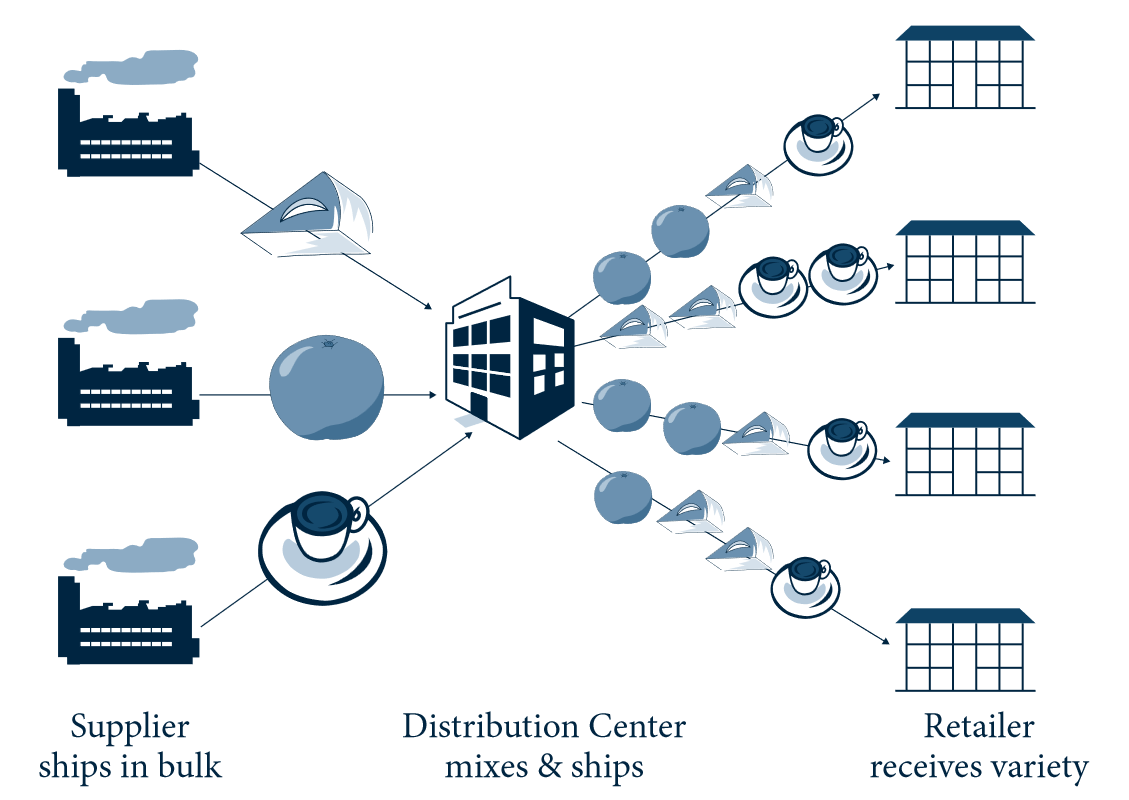
Assortment involves the assembly of customer orders for multiple SKUs held in the distribution facility. As Figure 10.2 highlights, the facility provides a product mixing capability, allowing customers to quickly order a variety of items from a single location. This avoids the expenses related to placing numerous orders and having them shipped from a variety of locations. Just as companies benefit from the assortment function, individuals gain from the assortment/product mixing concept when shopping for food. Rather than traveling to the butcher shop, bakery, dairy store, and produce market, we make a single trip to the grocery store, saving us time and transportation costs. Given the congestion, capacity, and fuel costs faced by industry today, this product mixing role is a key distribution facility capability.
Page 399 2023-04-26#11:47 am
Page 399 2023-03-13#9:27 am
4.4.5 Value-Adding
Value-added activities help organizations handle special customer requirements, create supply chain efficiencies, and differentiate themselves from the competition.
- Assembly
- Inventory management and visibility
- Product kitting, bundling, and unbundling
- Product postponement
- Production sequencing
- Quality control
- Recycling, repair, and returns management
Assembly services—Handle limited/light assembly of products such as building and filling in-store display units. - Inventory management and visibility—Provide consignment and vendor-managed inventory programs. - Product kitting, bundling, and unbundling—Build customized combinations of products to meet specific customer requirements such as all components needed for a customized smartphone bundle or repacking a combination of goods for retail promotion (gift with purchase or multipack goods). - Product postponement—Conduct specific activities (assembly, sizing, packaging, and/or labeling) that have been delayed until customer places order. - Production sequencing—Prepare inventory for just-in-time line-side delivery to manufacturing facilities. Components are picked, loaded, and delivered in the precise sequence needed for assembly. - Quality control—Verify the product quality, condition, and count before it is delivered to the customer. - Recycling, repair, and returns management—Provide services related to reverse flows of products from customers such as inspection, disposal, refurbishment, or credit.
Page 400 2023-04-26#12:24 pm
The value-added activities highlighted in Table 10.1 help organizations handle special customer requirements, create supply chain efficiencies, and differentiate themselves from their competition.
Page 400 2023-04-26#12:19 pm
4.5 Main Warehouse Types in a Supply Chain
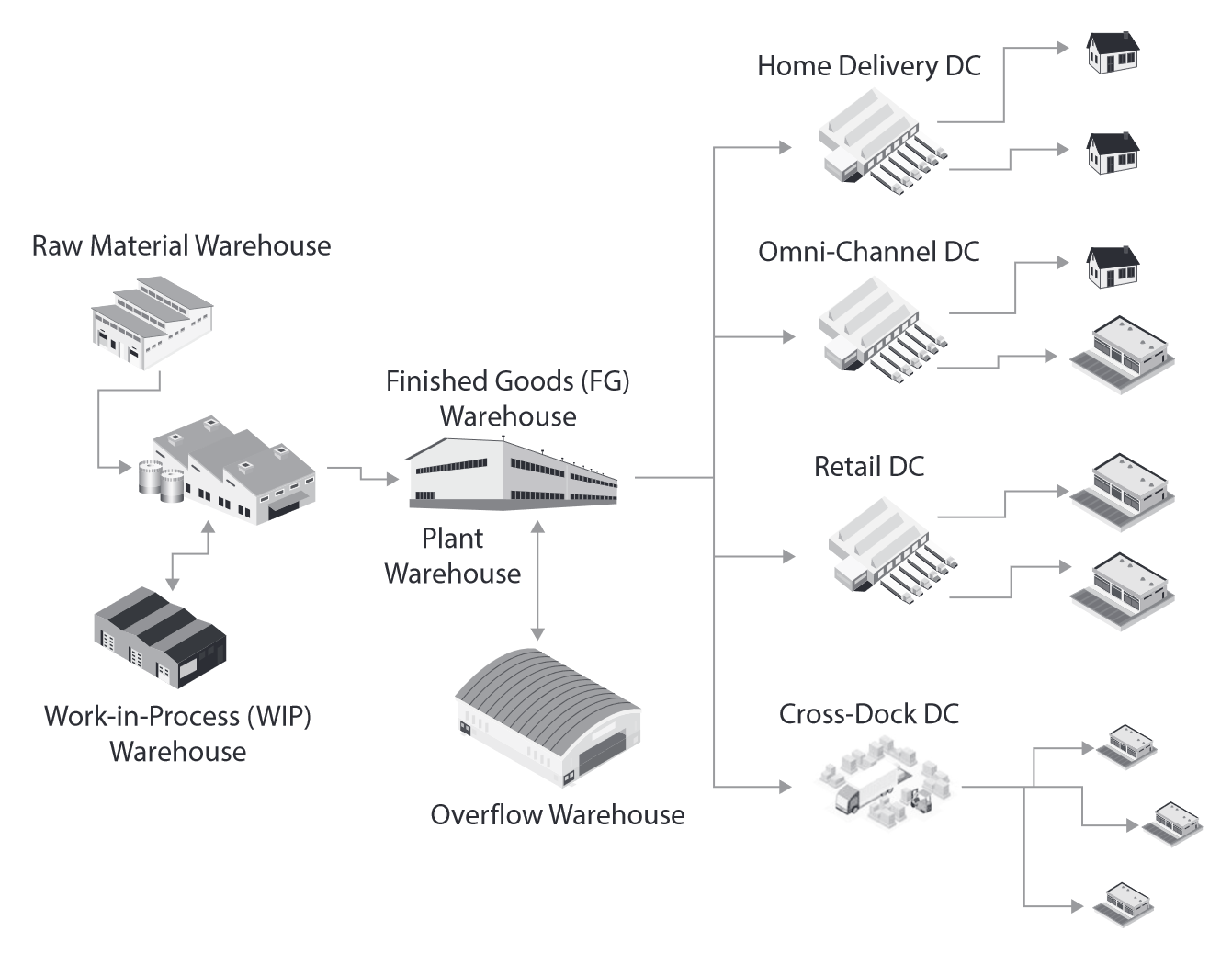
Page 30 2023-04-15#6:49 am
REMARK: Retail back rooms, tool cribs, storerooms, and parts lockers are also forms of warehouses that do not carry the warehousing name
Page 31 2023-04-19#4:24 am
4.5.1 Raw Material Warehouse
Store raw materials (e.g., plastics, sand, precious metals, etc.) near to:
- Extraction point
- Manufacturing point
before they enter production, prioritizing protection from the elements, quick identification, and safe heavy handling.
Raw materials are held to ensure continuous production.
4.5.2 Work-In-Process (WIP) Warehouse
Holds inventory in or near factories and buffers semi-finished items between steps, keeping flow stable when cycle times vary.
4.5.3 Plant Warehouse
Feeds production with inbound parts, kitted materials, and container management, often with cross-dock lanes and close coupling to the shop floor.
4.5.4 Finished-Goods/Plant Warehouses
Holds products prepared for sale, awaiting transfer to distribution centers, for manufacturers, wholesalers, and retailers. Acts as a buffer stock for companies, enabling them to prepare for:
- Launching new products.
- Anticipated demand surges.
- Seasonal fluctuations.
4.5.5 Overflow Warehouse
Usually situated close to plant warehouses, provides additional capacity during peak periods (seasonal inventory), special promotions, or unexpected disruptions, ensuring the main facility remains efficient and uncongested. Overflow warehouses are commonly operated under short-term agreements by third-party logistics providers or on-demand services.
4.5.6 Distribution Center (DC) Warehouses
DCs are located much closer to the customer base than are plant warehouses. They typically receive product from many plant warehouses and serve customers with same- or next-day delivery. Differently from warehouses, DCs typically store goods for shorter periods of time as orders are fulfilled.
The delivery point for the DC determines its name:
- Home delivery DCs deliver to homes.
- Retail DCs deliver to retail stores.
- Omni-channel DCs deliver to a mix of homes and retail stores.
- Cross-dock DCs do not hold product but simply mix and sort.
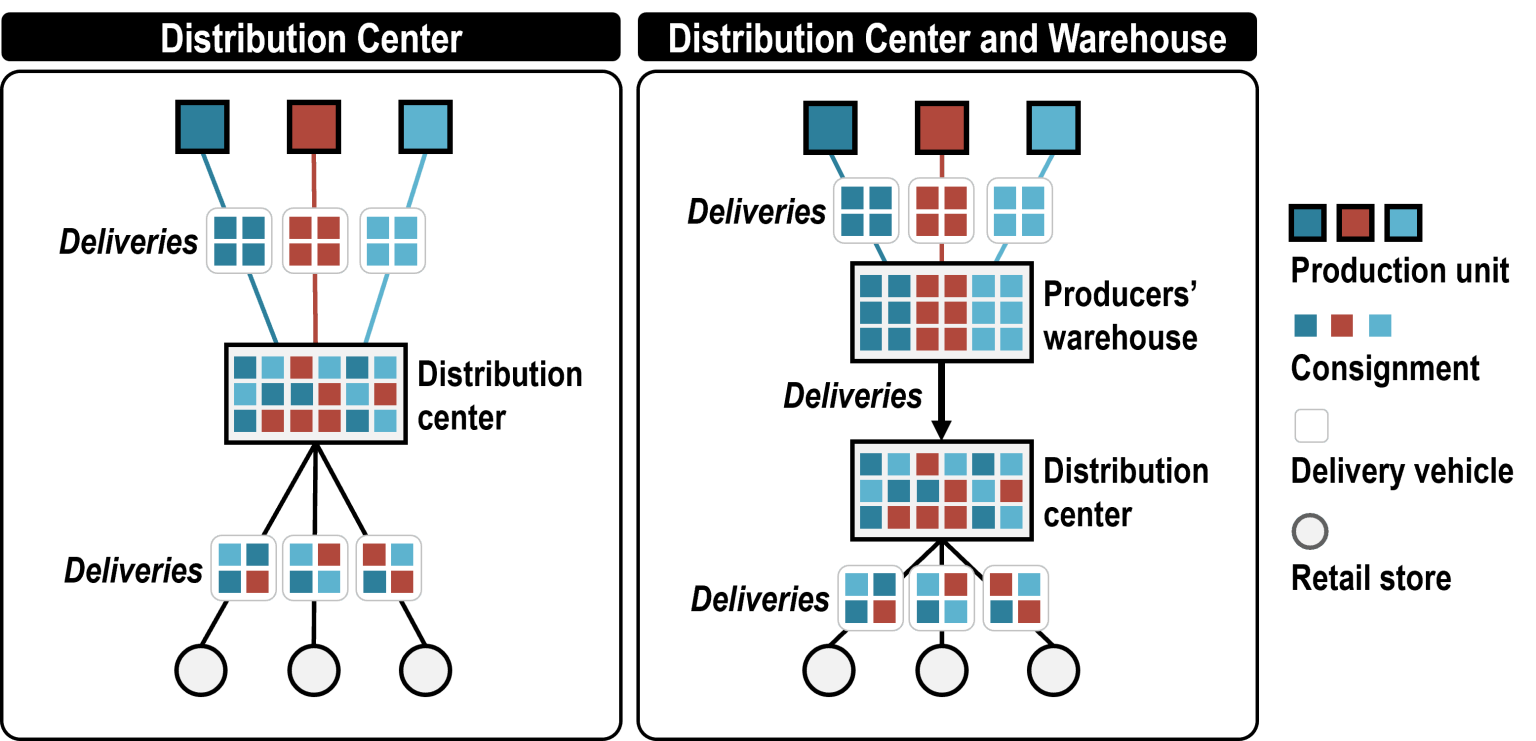
Distribution center warehouses are located much closer to the customer base than are plant warehouses. Distribution centers typically receive product from many plant warehouses and serve customers with same- or next-day delivery. The delivery point for the distribution center determines its name. Home delivery distribution centers deliver to homes. Retail distribution centers deliver to retail stores. Omni-channel distribution centers deliver to a mix of homes and retail stores. Cross-dock distribution centers do not hold product but simply mix and sort.
Facility that:
- Receives, stores, and ship products directly to a retailer, wholesaler or directly to the consumer.
- Usually the products are shipped in bulk or on a pallets.
- Commonly located at the outskirts of cities with good transport connections.
- Distribution centers: national or regional used for storage located in the outskirts of cities with good transport connections.
[Pasted image 20221208145546.png]]
Warehouse vs. Distribution Center Explained (wisys.com) You might also see a distribution center referred to as a DC, warehouse, cross-dock facility, package handling center, fulfillment center, or a bulk break center.
Warehouses and Distribution Centers | The Geography of Transport Systems (transportgeography.org)
[Pasted image 20221208151419.png]] Cross-Docking Distribution Center | The Geography of Transport Systems (transportgeography.org)
Page 31 2023-04-15#6:56 am
4.5.7 Cross-dock Centers
Cross-dock centers are facilities designed to quickly identify and consolidate items with other deliveries, preparing them for dispatch. Their primary objective is to ensure same-day receipt and dispatch, minimizing the time items remain in the warehouse. To achieve this, items must be pre-labeled and ready for immediate onward delivery. Typical products handled in cross-dock centers include perishable goods such as fruits, vegetables, meat, and fish, which require rapid movement through the supply chain.
Implementing cross-docking effectively requires overcoming several barriers:
- Warehouse Management Systems: Insufficient integration and lack of real-time data sharing can hinder operations.
- Quality Control: Maintaining product quality during rapid handling is critical.
- Supplier and Carrier Reliability: Strong partnerships and effective communication are essential.
- Warehouse Design: Layouts must facilitate efficient movement and sorting of goods.
- Demand Uncertainty: Fluctuations in demand can disrupt planned operations and inventory levels.
4.5.8 Bonded/Customs Warehouse
Typically sitting outside the customs territory, bonded warehouses allow storage and manipulation of imported goods with duties deferred until release for free circulation, which improves cash flow and simplifies re-export.
4.5.9 Fulfillment Center (FC) Warehouses
Fulfillment centers are the critical supply chain link between manufacturing and the end consumer. These warehouses are designed and equipped specifically to manage large volumes of small orders (typically from e-retailing).
An FC aims at shipping orders quickly in and out, not long-term storage. It can also function as a returns processing center (e-commerce has a larger percentage of returns than normal retail activities). Figure 4.7 shows the fulfillment process at bol.com, a large Dutch e-commerce company owned by Ahold Delhaize.
4.5.10 Amazon Fulfillment Centers
Amazon’s Fulfillment by Amazon (FBA) service provides comprehensive logistics solutions, including storage, customer service, and returns. Sellers using FBA benefit from Amazon’s extensive fulfillment network, allowing them to reach a larger customer base. Products are picked, packed, and shipped directly to end customers. Due to the large assortment of products, Amazon operates several types of fulfillment centers to optimize its operations, including:
- Sortable FCs: Handle smaller, easily sortable items such as books, toys, and housewares.
- Non-sortable FCs: Manage larger, bulky items like washing machines, pianos, patio furniture, and rugs.
- Sortation Centers: Sort customer orders by their final destination and consolidate them onto trucks for faster delivery.
- Receive Centers: Accept large quantities of fast-moving goods and distribute them across the fulfillment center network.
- Delivery Stations: Prepare orders for last-mile delivery, ensuring fast and efficient everyday delivery.
- Specialty Centers: Focus on specific categories of items or support peak season operations, such as during holidays.
4.5.12 Contract Warehouse
Contract warehouses are managed by third-party logistics providers and are typically dedicated to serving a single client for an extended period. These facilities offer customized solutions tailored to the specific needs of the client, ensuring efficient and reliable operations.
4.5.13 Public Sector Warehouse
Warehouses that support public sector operations, military logistics, and third-sector organizations. Examples include:
- Humanitarian aid warehouses: Strategically located facilities established by third-sector organizations to enable rapid response to natural disasters such as earthquakes, droughts, and tsunamis.
- Local government storage: Warehouses used to store supplies for schools, offices, and other municipal facilities, including items like stationery, uniforms, furniture, and IT equipment.
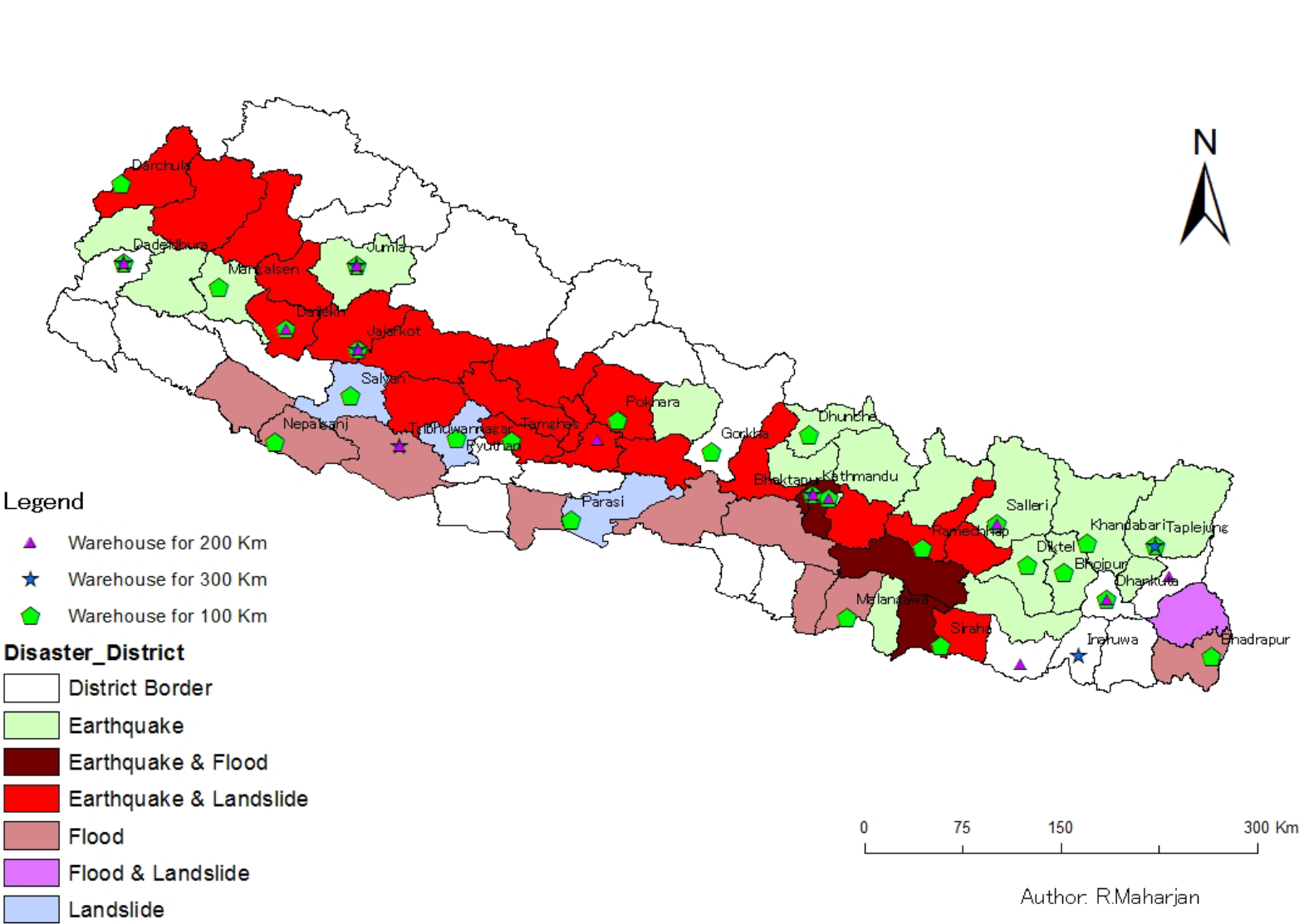
4.5.14 Intermediate, Postponement, Customization, or Sub-assembly Warehouse
Facilities designed to temporarily store products at various stages of production and perform customization tasks prior to final delivery to customers.
Examples of postponement and sub-assembly activities include:
- modifying or adding packaging or labeling (e.g., language-specific labeling);
- assembling computers with customized hardware components (e.g., graphics cards, memory modules);
- incorporating country-specific features (e.g., electrical adapters);
- creating promotional product bundles.
4.5.15 Consolidation Centers and Transit Warehouses
Consolidation centers streamline supply chains by 1) receiving products from multiple sources and 2) combining them for efficient delivery to customers or production lines. They are often managed by third-party logistics providers.
Key types include:
- Just-in-Time (JIT) centers: Deliver and sequence automotive parts for precise production line delivery.
- Retail stock consolidation warehouses: Aggregate products from various suppliers for streamlined retail store delivery. ### Transshipment or Break-bulk Warehouses
Facilities that receive large shipments and break them down into smaller, more manageable quantities for distribution to various locations. These warehouses are essential in supply chains where products are transported in bulk but need to be delivered in smaller quantities to multiple destinations. Figure 4.10 shows an example of a transshipment warehouse.
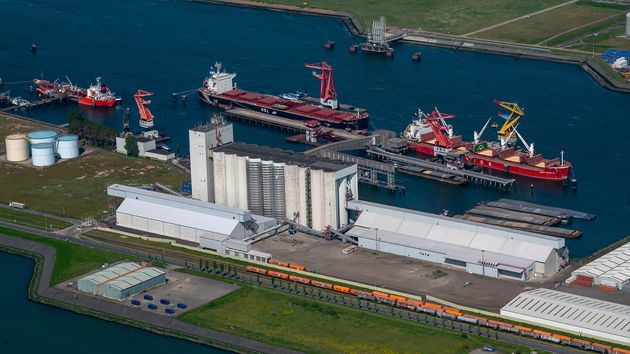
4.5.16 Sortation Center (Hub)
Sortation centers play a critical role in the logistics network by:
- Sorting goods based on zip/postcode;
- Consolidating shipments for efficient distribution;
- Dispatching items overnight to their respective delivery areas.
These facilities are primarily utilized by letter, parcel, and pallet distribution companies. Figure 4.11 illustrates a robotic sorting system in a Chinese warehouse, showcasing the efficiency of modern automation in handling high volumes of packages.
4.5.17 Perishables Warehouse
Handle short-shelf-life products (e.g., food, fresh flowers, vaccines).
- Serve as a critical link in the cold chain, ensuring perishable products are delivered to consumers quickly.
- Products typically dwell for very short periods, often just hours.
- Optimize space management due to high refrigeration costs.
- Ship products using FIFO (First-In-First-Out) or FEFO (First-Expired-First-Out) principles.
- Adhere to strict handling requirements:
- Maintain different temperature zones for various products (e.g., chilled and frozen areas).
- Follow stacking rules to prevent damage and ensure safety.
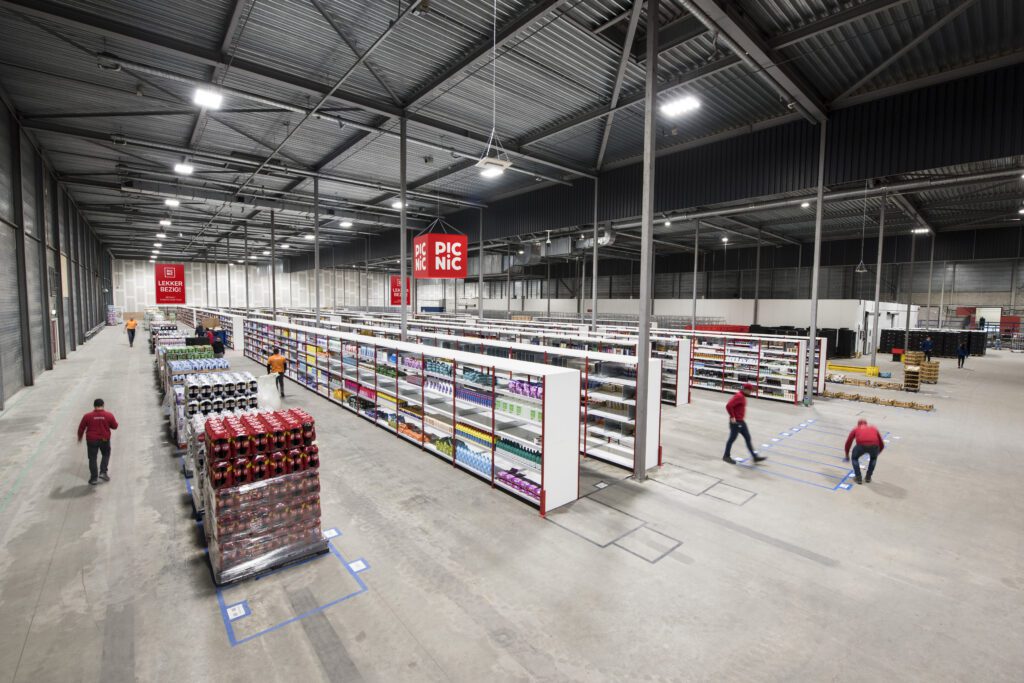
4.5.18 Reverse Logistics (Returns) Centers
Warehouses dealing with returned items, such as:
- Unwanted or defective items. They are returned to the stores by customers, consolidated by third-party contractors, and sent to returns centers. After being checked, items can be repackaged, repaired, recycled, or disposed of (in an environmentally friendly manner, e.g., used as fuel).
- Reusable transit packaging (e.g., roll cages, barrels, kegs, pallets, tote boxes, trays). When used in the food industry, added services include washing and sanitizing the items before they re-enter the supply chain (e.g., kegs, “empties” returned to Heineken’s warehouses).
Reverse logistics centres The growth of e-retailing and specific environmental legislation such as the European Union’s Waste Electrical and Electronic Equipment (WEEE) Directive (2007) has compelled companies to focus time and energy on reverse logistics. Today, companies recognize that returning product to stock or disposing of it quickly can positively affect cash flow. As a result, a number of warehouses have been set up specifically to deal with returned items. Third-party contractors are providing a service to retailers where customers return unwanted or defective items to the stores; the items are then consolidated and sent to the returns centre, where they are checked and either repackaged, repaired, recycled or disposed of. Waste legislation has also resulted in large quantities of returned packaging having to be disposed of in an environmentally friendly manner. This includes sortation by type and use as fuel or recycled material. There are case studies in the environmental section that go into more detail on this subject. Other reverse logistics processes include the return of reusable transit packaging equipment such as roll cages, barrels, kegs, pallets, tote boxes and trays. When used in the food industry added services include washing and sanitizing the items before they re-enter the supply chain. For example, Norbert Dentressangle, a 3PL, service and maintain more than a million roll cages, as well as 230 million trays and flower buckets and dollies for Tesco.
Page 30 2023-04-19#6:33 pm
4.6 Warehouse Size Typology (XXS To XXL)
Onstein et al. (2021) propose a typology for logistics facilities based on footprint size. The typology aims to support policymakers, planners, and researchers in characterizing logistics real estate and understanding its role in urban and regional freight systems. It is based on a review of existing literature, industry reports, and expert interviews, with a focus on the Netherlands but applicable more broadly. Table 4.1 shows an overview of the typology. For each size class, it includes:
- Building Size: The floor-area band in square meters that corresponds to the class and the distribution of surface area across size bands surveyed in the paper.
- Function: The activity type(s) the facility performs: S = Storage, C = Consolidation, W = Warehousing (receive, putaway, pick), D = Distribution (reduce transit time), CD = Cross-dock, VAL = Value-Added Logistics (e.g., relabel, kit).
- Product Type: The goods the site handles, distinguishing between generic flows (parcels, pallets, bulk) and specific categories with handling or temperature constraints (e.g., fresh food, industrial equipment).
- Product Range And Speed: Two linked descriptors on one axis: range (small to large assortment) and speed (slow movers and fast movers). A broad, fast assortment tends to push size and mechanization up; a narrow, slow range can be served from smaller footprints.
- Market Service Area: The geographic scope the facility serves: neighbourhood, town/city, regional, national, international.
- Service Days: The promised delivery time from the facility to the customer, expressed in days, e.g., same day, next day, multi-day.
- Number Of Facilities In The Netherlands: A count field drawn from the Dutch database the authors use.
- Types Represented In Each Size Range: Which of the facility types are observed in that band. Facility types included:
- Parcel lockers & pick-up points
- City hubs (incl. UCCs)
- Parcel & postal sorting facilities
- Regional food wholesale/retail DCs
- National retail & e-commerce DCs
- Manufacturer DCs
- Bulk facilities
- Global agricultural auctions
The size bands are for reference and analysis purposes. If local policy or a dataset uses slightly different breakpoints, document the mapping in text next to Table 4.1. For example, Acocella et al. (2024) focuses on large sites only, and defines L = 10,000–20,000 m², XL = 20,000–40,000 m², XXL > 40,000 m².
| Name | Building size | Function | Product type | Product range and speed | Market service area | Service days | Number of facilities in the Netherlands | Types represented in each size range |
|---|---|---|---|---|---|---|---|---|
| XXS | < 200 m2 | S / D / (and C only for online goods returns) | Parcels | Broad range High speed |
Local: Neighbourhood | Same day Next day |
> 8.680 pick up points and parcel lockers | Parcel locker Pick up points |
| XS | 200 - < 2,000 m2 | S / C / W / D | Parcels Fresh food delivery |
Broad range High speed |
Local: Town / City | Same day Next day |
Unknown | City hub |
| S | 2,000 - < 8,000 m2 | S / C / W / D | Parcels | Small / broad range Fast-movers / slow-movers |
Regional | Next day | 995 | Parcel and postal sorting facility |
| M | 8,000 - < 15,000 m2 | S / C / W / D / CD / VAL | Parcels Pallets Bulk |
Small / broad range Fast-movers / slow-movers |
Regional National |
Next day Multiple days |
1024 | Parcel and postal sorting facility Regional food wholesale and retail National retail or e-commerce facility Bulk facility |
| L | 15,000 – < 20,000 m2 | S / C / W / D / CD / VAL | Parcels Pallets Bulk |
Small / broad range Fast-movers / slow-movers |
Mostly National and International (although there are large regional Post and Food retail DCs) | Next day Multiple days |
319 | Parcel and postal sorting facility Regional food wholesale and retail National retail or e-commerce facility Manufacturer DC facility Bulk facility |
| XL | 20,000 - < 40,000 m2 | S / C / W / D / CD / VAL | Parcels Pallets Bulk |
Small / broad range Fast-movers / slow-movers |
Mostly National and International (although there are very large regional Post and Food retail DCs) | Next day Multiple days |
411 | Parcel and postal sorting facility Regional food wholesale and retail National retail or e-commerce facility Manufacturer DC facility Bulk facility Global agricultural auction |
| XXL | > 40,000 m2 | S / C / W / D / CD / VAL | Parcels Pallets |
Small / broad range Fast-movers / slow-movers |
National International (although there are very large regional Post and Food retail DCs) |
Multiple days (online possibly faster) | 146 | Parcel and postal sorting facility Regional food wholesale and retail National retail or e-commerce facility Manufacturer DC facility Global agricultural auction |
Figure 4.13 visualizes the size bands. For reference, the last band was set to 1,000,000 m², the reported floor area of Royal FloraHolland in Aalsmeer, the world’s largest flower auction complex near Schiphol (see Figure 4.14).
